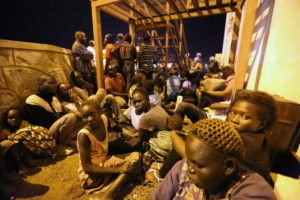Last weekend, heavy fighting broke out between government and opposition soldiers in Juba, South Sudan, killing approximately 300 and displacing thousands. It has been nearly a year since a peace agreement was signed in August 2015 to end the “meaningless war,” as President Salva Kiir has characterized it, but little progress has been made to implement the agreement.
What is most worrisome about this latest episode of violence is it appears that no one knows why there is fighting and who is in control. On July 8th, after the violence initially broke out, President Kiir, joined by First Vice President Riek Machar and Vice President James Wani Igga, stated at a press conference, “What is happening outside is something that we cannot explain to you.”
As fighting continued to intensify over the weekend, from small-arms fire to the use of helicopter gunships and artillery, government spokesperson Lul Ruai Koang told Foreign Policy, “We do not know why and who started it.”
This latest example of the inability of President Kiir and First Vice President Riek Machar to lead their country to peace should cause the international community to rethink their engagement with the two leaders, and to look for an alternative path forward, in consultation with the South Sudanese people.
In the five years since the fledgling country became an independent nation, under the leadership of Kiir and Machar, South Sudan has spent more time embroiled in conflict than at peace. The August 2015 peace agreement was supposed to bring a brighter future, but it was flawed from the start, with little buy-in from the opposing sides, and months of ceasefire violations.
The peace deal brought Kiir and Machar—the same leaders who drove the country into a brutal civil war—back together in a power sharing agreement. Some were skeptical about the peace agreement holding, while others, including President Kiir, declared it doomed from the start. In a recent interview with Al Jazeera, Kiir stated that even during his signing of the agreement he said, “this agreement was not made to be implemented.”
Given these sentiments, the deep mistrust that exists between Kiir and Machar, and the recent violence, it seems unlikely that the two men will be able to work together to: repair the fractures that they helped create throughout the country, heal the open wounds left by the recent conflict, address the dire humanitarian situation facing the 2.3 million displaced and over five million who are severely food insecure, and save the near collapse of South Sudan’s economy.
With violence plaguing the streets of Juba once again, and a clear lack of command and control by Kiir and Machar over their troops, it may be the proof needed to seek alternative approaches to help South Sudan out of this cycle of violence. This would mean taking a few steps back in the current peace process, but as it stands the peace process has failed to be implemented, and the current leadership has shown their inability to work together. If we keep the status quo, peace may be impossible to achieve.
Recommendations:
Many recommendations are focused on the short-term, an immediate arms embargo, sanctions, bolstering the United Nations force, etc. The below recommendations are focused on the long-term prospects for a sustainable peace.
- The international community, led by the Intergovernmental Authority on Development (IGAD)—the guarantors of the peace agreement—and the United Nations (UN) Security Council, should work with President Kiir and First Vice President Machar to extricate themselves from power. IGAD and the UN, in consultation with South Sudanese civil society, should temporarily establish transitional authority over South Sudan, with a fixed deadline.
- The transitional authoritative body should be focused on four primary objectives:
- Disarm and demobilize SPLA and SPLA-IO forces in Juba and begin reconciliation and reintegration efforts with the soldiers and the community
- Address the basic human needs of the South Sudanese vulnerable populations who are displaced and facing famine level food insecurity
- Bolster the UN peacekeeping mission UNMISS, enabling it to patrol outside of protection of civilian sites and provide security for the people of South Sudan
- Stabilize the economy
- Put South Sudan on a path towards free and fair elections to give the South Sudanese people a chance to control their future
- After elections take place, the transitional authority should remain as advisors to the newly elected President and appointed cabinet members for a period of one year to assist with the transition
These recommendations are by no means an immediate solution to the current crisis in South Sudan. Getting South Sudan to move out of conflict and towards stable fragility will take time, and no one proposed action will solve these issues overnight. But, at this point, these recommendations may be the least bad option available to help put the world’s newest nation on a path towards a durable peace. It’s clear that the current strategy is not working.
**Update 7/14/2016** Since this post was written a ceasefire was called by both Kiir and Machar over the Sudan People’s Liberation Army (SPLA) and SPLA in opposition (SPLA-IO), and at the time of this update, it seems to be holding. There are some reports that Machar and his SPLA-IO forces have left Juba to separate the forces and limit further confrontation; a temporary solution at best. It is not yet certain whether the ceasefire will be permanent, and if Kiir and Machar will be able to control their troops in the future. The next few days and weeks will be an important benchmark, but given the recent violence, it is clear the factions are still very much divided and the leadership quite weak.


